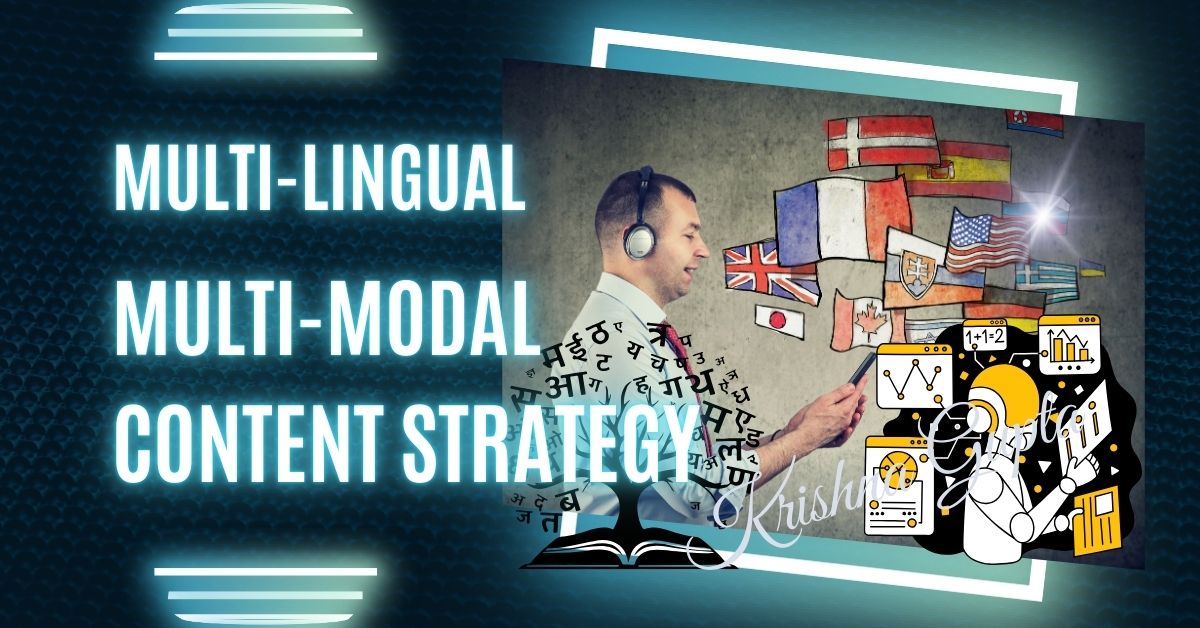Multi-lingual and Multi-Modal Content Strategy in AI Optimisation: Driving Global Impact Through Diversity
In the modern digital ecosystem, content is not just king—it’s the currency of intelligence. As Artificial Intelligence (AI) continues to permeate every business vertical, the way content is created, consumed, and optimised is undergoing a seismic shift. A multi-lingual and multi-modal content strategy is no longer a futuristic idea but a critical business imperative for global relevance and reach.
Why Multi-lingual and Multi-modal Strategies Matter Now
Today’s customers expect personalised, relevant, and accessible content, whether they’re in Manchester, Mumbai, or Maputo. However, personalisation cannot exist without linguistic inclusion and format diversity. If your AI systems are only trained on English or text-based content, you’re not just missing out—you’re limiting intelligence and impact.
Consider this:
- Over 75% of the global population does not speak English.
- Over 60% of content consumption now happens via non-text formats like video, voice, or images.
- AI systems trained on narrow data deliver narrow results. And in a global economy, narrow is costly.
The Multi-lingual Advantage in AI Optimisation
1. Enhanced Reach and Accessibility
Language localisation opens doors to new markets, improves SEO performance, and enhances user trust. AI-driven content that speaks your customer’s language (literally) increases both conversion rates and brand loyalty.
Case in Point: Netflix uses AI to automatically translate and subtitle content in 30+ languages—unlocking global binge-watching.
2. Bias Reduction and Model Accuracy
AI models trained on diverse linguistic data reduce inherent language and cultural bias. This leads to fairer algorithms, more robust performance, and better cross-cultural adaptability.
Example: Meta’s “No Language Left Behind” project is enabling translation for low-resource languages such as Lao and Urdu.
3. Future-Ready Data Infrastructure
Multi-lingual content ensures your AI pipelines are scalable, future-proof, and ready for global expansion without costly overhauls.
The Power of Multi-Modal Content
“Modality” refers to the form of content—text, image, audio, video, etc. In today’s hyper-connected world, users shift across devices, platforms, and formats. AI must adapt.
1. Contextual Intelligence
Multi-modal data provides richer contextual cues for AI. For instance, combining facial expressions (video) with speech tone (audio) improves sentiment analysis drastically.
Use Case: Duolingo integrates gamification, speech recognition, and visual storytelling to revolutionise language learning.
2. Improved User Engagement
Audiences retain 95% of a message when it’s in video form, compared to 10% with text. AI systems that understand and deliver modality-based content significantly enhance customer engagement metrics.
Use Case: YouTube’s AI-driven auto-captioning and multilingual subtitles enable billions of users to access content in their own language and style.
3. AI Model Performance Boost
Multi-modal datasets (e.g., OpenAI’s GPT-4, Google Gemini) outperform unimodal ones in complex tasks like image-text reasoning, multi-lingual summarisation, and personalised recommendations.
Optimising AI Through Strategic Content Design
✅ AI-First Content Creation
Use AI tools to:
- Generate multi-lingual versions of your blog, podcast, or video.
- Auto-caption and voice-over for video content.
- Summarise long articles into tweet-sized insights (multi-modal compression).
✅ Smart Distribution Across Formats
AI can predict which content format (video, audio, infographics) performs best per user segment—then optimise in real time.
✅ Feedback-Driven Content Intelligence
AI-driven analytics tools (like Hotjar, Pendo, or HubSpot AI) help you:
- Track format-level performance.
- Understand language-wise engagement.
- Optimise for ROI in every demographic.
Real-World Challenges
Despite the promise, implementation isn’t frictionless.
| Challenge | Description |
| 🧩 Translation Errors | Even advanced AI can mistranslate idioms or cultural references. |
| 🧠 Contextual Loss | Modality-specific meaning may not translate well into other formats. |
| 💸 Cost & Complexity | Maintaining multi-lingual and multi-modal pipelines can strain resources. |
| 🧑⚖️ Ethical Pitfalls | Inaccurate translations can lead to brand damage or regulatory issues. |
Pro Tip: Combine AI with Human-in-the-loop (HITL) systems for quality assurance.
Best Practices for Execution
- Prioritise Core Languages and Modalities
Start with 5–7 high-impact languages and formats based on your audience analytics. - Leverage Multi-lingual LLMs and Open Source AI
Tools like mBERT, Whisper, MarianNMT, and BLOOM allow cost-effective, scalable deployment. - Create Once, Repurpose Forever
Use central content hubs (blogs, webinars) to generate derivative assets across languages and formats. - Align With Your AI and Content KPIs
Every translation or video should tie back to measurable goals: engagement, traffic, conversion, satisfaction.
Looking Ahead: The Future is Polyglot and Multi-sensory
We are entering an era where AI understands nuance, tone, image, and voice—all in your customer’s native language. Businesses that embrace a multi-lingual and multi-modal content strategy are not just keeping up with trends—they are building intelligent, inclusive, global-first brands.
“Language is the bloodstream of culture. Format is the voice of emotion. AI is the mind that connects them.”
Final Thoughts
In an increasingly AI-powered world, language and format diversity are not just features—they are foundations for impact. Whether you’re scaling a SaaS business across continents or building the next-gen AI assistant, integrating multi-lingual and multi-modal content strategy into your AI optimisation plan is not optional—it’s essential.

Let your content speak every language, in every format, across every platform—intelligently, inclusively, and optimally.